


Here’s an unusual little diversion, which I’ve been saving for a rainy day (though there’s not a drop in the sky). Not really much of a trail – more like a bridle path, fitting neatly into one installment. A tribute to a genre of music, which, while it only showed up rarely in cartoons, made its mark in memory, and kept popping up now and then over the years as a reminder that the style had not disappeared, and still carried a mark of the exotic that could generate sales – especially in the 50’s and 60’s, when several recordings became mainstream hits, primarily thanks to the efforts and promotion by RCA Victor and renown singer Harry Belafonte.

The origins of pop exposure of Calypso to the United States, however, trace back much farther than that. Before 1933, some Trinidadian entertainers performed in black vaudeville, when there were sizeable West Indian communities in the larger American cities. In 1934, Trinidadian entrepreneur Edward Sa Gomez sent two calypsonians who styled themselves as “The Lion” and “The Atilla” to New York, to record the latest carnival hits for Melotone, Perfect, Banner, and Oriole.
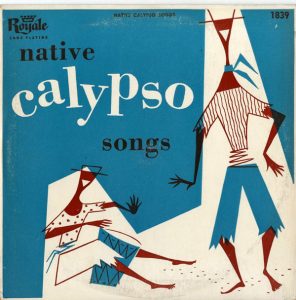 Both singers appeared on Rudy Vallee’s Fleischmann’s Hour radio program, where The Lion introduced one song which would become known for years, “Ugly Woman”. This would become the basis for the Rock and Roll hit, “If You Wanna Be Happy” in 1963 for Jimmy Soul. Over the next few years, Decca records would take over recording chores, and Sa Gomez would send two, three, and sometimes four of such singers during the Lenten season for recording duties, just after Mardi Gras. These included “The Tiger”, “The Executor”, and “The Duke of Iron”. After 1936, Decca would send a field unit down to Port of Spain (a duty the engineers probably loved), recording many of the same artists, but with different local orchestra backings (rather than the New York sessions, which all used the same band, Gerald Clark and his Caribbean Serenaders). Trinidad and the West Indies earned their own pavilion at the New York World’s Fair, and brought Wilmouth Houdini, another veteran performer, who recorded an entire album of Calypso for Decca, aimed at a broader market than just the West Indian contingent of Harlem.
Both singers appeared on Rudy Vallee’s Fleischmann’s Hour radio program, where The Lion introduced one song which would become known for years, “Ugly Woman”. This would become the basis for the Rock and Roll hit, “If You Wanna Be Happy” in 1963 for Jimmy Soul. Over the next few years, Decca records would take over recording chores, and Sa Gomez would send two, three, and sometimes four of such singers during the Lenten season for recording duties, just after Mardi Gras. These included “The Tiger”, “The Executor”, and “The Duke of Iron”. After 1936, Decca would send a field unit down to Port of Spain (a duty the engineers probably loved), recording many of the same artists, but with different local orchestra backings (rather than the New York sessions, which all used the same band, Gerald Clark and his Caribbean Serenaders). Trinidad and the West Indies earned their own pavilion at the New York World’s Fair, and brought Wilmouth Houdini, another veteran performer, who recorded an entire album of Calypso for Decca, aimed at a broader market than just the West Indian contingent of Harlem.
With the advent of World War II, Trinidad became a major center of oil production for the Allies. A lot of servicemen passed through on their way to various fronts. A song credited to, of all people, Morey Amsterdam, became very popular in both Trinidad and America – the Andrews Sisters’ “Rum and Coca Cola”, which also became the center of a major plagiarism lawsuit, as documented by Louis Nizer in his book, “My Life In Court”. A few years later, another Calypso based pop would make the recording rounds, including by Mildred Bailey, entitled, “All That Glitters Is Not Gold.”
 For animation, it all began with a Columbia cartoon, in which a real Calypso artist (Sir Lancelot), popular in both recordings and in film and radio appearances on the West Coast, was hired as a guest voice artist for a wartime spirit-builder titled The Disillusioned Blue Bird (Columbia/Screen Gems, Color Rhapsody, 6/15/44 – Howard Swift, dir.) Our scene opens on what appears to be a tranquil night sky, with incidental singing by the Rhythmettes telling of the bluebird’s association with happiness, and of hearing it sweetly calling. But the call we hear is far from happy. Like a comet, out of the skies zooms an already bandaged and partially battered bluebird, screaming at the top of its lungs, “HELP!!!” Why? Right on its tail is a falling aerial bomb. The bird narrowly avoids disaster, by grabbing hold of the edge of a small cloud off to one side, and pulling himself out of the way of the falling projectile. He watches from a perch on the cloud as the bomb loudly explodes below. Immediately following impact, a sextet of searchlights zeroes in upon him from below, apparently pegging him as the enemy and target for tonight. From above, a squadron of fighter planes breaks formation, and swoops down upon him, machine guns firing. Anti-aircraft guns join in the firing from below. Years before Chuck Jones, the bluebird pulls a standard Wile E. Coyote defensive maneuver – opening a feeble umbrella to ward off the bullets. One hits the umbrella fabric – and immediately burns it to a sizzling skeletal frame. An ack ack shot from below bursts the cloud on which the bird sits, like a punctured balloon, and it zips along through the sky, with the bird dangling along by the grip of one wing. It is intercepted by a large shell fired from cannon below. The bird continues to hold on until what is left of the cloud disintegrates, and there is nothing left to ride but the shell itself. The shell continues to rise high above the Earth, first icing up like an ascending plane, covering the bird in snow, then rising above the cold into the sunshine, leaving the parched bird attempting to cool himself with a small hand fan. Finally, the shell descends upon the isle of Trinidad. A local population of crows is enjoying a leisurely siesta beneath the palms, when the shell hits right in the middle of them. However, while the shell creates a crater, which immediately fills with sea water from below, the positions where the birds snooze remain entirely undisturbed, and the noise of the event is barely worth the raising of a sombrero by one crow to investigate the cause.
For animation, it all began with a Columbia cartoon, in which a real Calypso artist (Sir Lancelot), popular in both recordings and in film and radio appearances on the West Coast, was hired as a guest voice artist for a wartime spirit-builder titled The Disillusioned Blue Bird (Columbia/Screen Gems, Color Rhapsody, 6/15/44 – Howard Swift, dir.) Our scene opens on what appears to be a tranquil night sky, with incidental singing by the Rhythmettes telling of the bluebird’s association with happiness, and of hearing it sweetly calling. But the call we hear is far from happy. Like a comet, out of the skies zooms an already bandaged and partially battered bluebird, screaming at the top of its lungs, “HELP!!!” Why? Right on its tail is a falling aerial bomb. The bird narrowly avoids disaster, by grabbing hold of the edge of a small cloud off to one side, and pulling himself out of the way of the falling projectile. He watches from a perch on the cloud as the bomb loudly explodes below. Immediately following impact, a sextet of searchlights zeroes in upon him from below, apparently pegging him as the enemy and target for tonight. From above, a squadron of fighter planes breaks formation, and swoops down upon him, machine guns firing. Anti-aircraft guns join in the firing from below. Years before Chuck Jones, the bluebird pulls a standard Wile E. Coyote defensive maneuver – opening a feeble umbrella to ward off the bullets. One hits the umbrella fabric – and immediately burns it to a sizzling skeletal frame. An ack ack shot from below bursts the cloud on which the bird sits, like a punctured balloon, and it zips along through the sky, with the bird dangling along by the grip of one wing. It is intercepted by a large shell fired from cannon below. The bird continues to hold on until what is left of the cloud disintegrates, and there is nothing left to ride but the shell itself. The shell continues to rise high above the Earth, first icing up like an ascending plane, covering the bird in snow, then rising above the cold into the sunshine, leaving the parched bird attempting to cool himself with a small hand fan. Finally, the shell descends upon the isle of Trinidad. A local population of crows is enjoying a leisurely siesta beneath the palms, when the shell hits right in the middle of them. However, while the shell creates a crater, which immediately fills with sea water from below, the positions where the birds snooze remain entirely undisturbed, and the noise of the event is barely worth the raising of a sombrero by one crow to investigate the cause.
“Hello? Nice good afternoon”, says the inquisitive crow to the newcomer, seen rising from the crater pool. “Nice? Good?”, responds the bluebird, showing off his war wounds, including a now smoldering and bandaged tail. To cheer him up from his blues, the crows strike up a catchy and multi-versed calypso entitled “How Come You Got the Misery? (Always Remember That You Are Free)”. The lyric is full not only of topical couplets such as “Though there is International confusion, no one should ever be disillusion”, and references to popular song hits of the day. such as “(There’ll Be Bluebirds Over) The White Cliffs Of Dover” and “A Nightingale Sang in Berkeley Square”. Try as the bluebird might to silence the singing (including a stifled run of swear words that both produces a “Censored” sign within the bluebird’s bill, followed by a bar of soap to wash his mouth out), the crows will not be averted from their uplifting ditty, and emphasize that the song of a bluebird is essential both to maintaining happiness and to inspiring battles on to victory. (One crow even poses as George Washington at Vally Forge, snow effects provided by another crow shaking white blossoms from a tree limb above.) The bluebird starts to get the message – especially when the crows point out a recipe for his own happiness, in the form of a local Senorita bird who is both lovely and eligible. Embraced in the arms of the Senorita, the bluebird can only remark to the final chorus of the song, “Who’s got misery?”
 8 Ball Bunny (Warner, Bugs Bunny, 7/8/50 – Charles M. (Chuck) Jones, dir.) – A well-remembered favorite, which many a viewer will recall from its frequent runs in syndication on local kids shows in the first package of post-1947 Bugs cartoons to be made available in 16mm. Bugs’s sleep is interrupted by an unexpected intruder dropping in – literally, by falling into his rabbit hole. The visitor is a penguin, wearing a top hat. The bird has been accidentally left behind by the departing troupe of an Ice Frolics show, and the penguin, in a hopeless effort to catch up with the trucks disappearing over a hill, has stumbled into Bugs’s abode. Seeing the bird “dressed” as if in evening attire, Bugs nicknames him “Playboy”, and criticizes him for leading his night life and disturbing honest rabbits’ slumber. But a rush of tears from the bird’s eyes draws Bugs’s sympathy, and he catches on, asking, “Ya lost er sumptin’?” A nod from the penguin (who is unable to speak), and Bugs promises to take the bird to his home. Bugs drops into his hole to pull out a research book from his unseen private bookshelves, and discovers the bird is a penguin, whose habitat is the South Pole. Bugs’s face contorts comically as realization hits regarding the promise he has just made. “South Pole!! OOOoooh, I’m DIE–in!!!”
8 Ball Bunny (Warner, Bugs Bunny, 7/8/50 – Charles M. (Chuck) Jones, dir.) – A well-remembered favorite, which many a viewer will recall from its frequent runs in syndication on local kids shows in the first package of post-1947 Bugs cartoons to be made available in 16mm. Bugs’s sleep is interrupted by an unexpected intruder dropping in – literally, by falling into his rabbit hole. The visitor is a penguin, wearing a top hat. The bird has been accidentally left behind by the departing troupe of an Ice Frolics show, and the penguin, in a hopeless effort to catch up with the trucks disappearing over a hill, has stumbled into Bugs’s abode. Seeing the bird “dressed” as if in evening attire, Bugs nicknames him “Playboy”, and criticizes him for leading his night life and disturbing honest rabbits’ slumber. But a rush of tears from the bird’s eyes draws Bugs’s sympathy, and he catches on, asking, “Ya lost er sumptin’?” A nod from the penguin (who is unable to speak), and Bugs promises to take the bird to his home. Bugs drops into his hole to pull out a research book from his unseen private bookshelves, and discovers the bird is a penguin, whose habitat is the South Pole. Bugs’s face contorts comically as realization hits regarding the promise he has just made. “South Pole!! OOOoooh, I’m DIE–in!!!”
 A series of globe-trotting adventures begins as Bugs and the bird follow their quest to reach the South Pole. At one point, Bugs thinks he’s found easy transportation for the bird, by way of a steamship named the Admiral Byrd. Packing some ice cubes for the bird to munch on the way, he ushers the penguin up the gangplank, and watches the ship depart. However, he didn’t count on the ship’s direction, and overhears two sailors remarking on the ship, “bound for Brooklyn.” After a spit-take, Bugs dives into the ocean, swimming after the ship to rectify the mistake. His arrival on deck could not be too soon – as he smells cooking in the ship’s galley. He looks in, to find the penguin hanging upside down by the feet, amidst the ship’s supply of poultry ready for the oven. “I leave ya alone for a few minutes and what happens? Ya end up on the menu.” The two jump overboard, and swim for the nearest convenient tropical island.
A series of globe-trotting adventures begins as Bugs and the bird follow their quest to reach the South Pole. At one point, Bugs thinks he’s found easy transportation for the bird, by way of a steamship named the Admiral Byrd. Packing some ice cubes for the bird to munch on the way, he ushers the penguin up the gangplank, and watches the ship depart. However, he didn’t count on the ship’s direction, and overhears two sailors remarking on the ship, “bound for Brooklyn.” After a spit-take, Bugs dives into the ocean, swimming after the ship to rectify the mistake. His arrival on deck could not be too soon – as he smells cooking in the ship’s galley. He looks in, to find the penguin hanging upside down by the feet, amidst the ship’s supply of poultry ready for the oven. “I leave ya alone for a few minutes and what happens? Ya end up on the menu.” The two jump overboard, and swim for the nearest convenient tropical island.
We fade out, then fade in to a close up of a gloved hand strumming a guitar. The camera cuts to a full view, of Bugs, sitting beneath a tree, dressed in tropical garb and islander hat, performing his own calypso, while the penguin carves away with an axe upon the felled trunk of a tree, carving out of wood a vessel for them to depart the island.
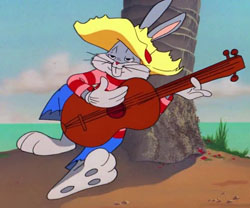 Bugs’s song is as follows.
Bugs’s song is as follows.
Bugs Bunny came to Martinique
When he arrive, he was pretty weak
His knees look like they would buckle in
His tribulations caused by a pen-gu-in
Now he build a boat on which they both can leave
He hope that fickle fate have nothing up her sleeve
If he should accomplish this daring thing
A mi-ra-cle to Martinique Bugs did bring.
This ditty was most likely penned by Michael Maltese, who was not above musical endeavors (as, I believe, he would be later responsible for “The Micjigan Rag” in “One Froggy Evening”). The number is interrupted between lines for a cameo by, of all people, a caricature of Humphrey Bogart, repeating a line used in an early sequence of “The Treasure of the Sierra Madre” to ask for a handout – “Say, pardon me, but could you help out a fellow American who’s down on his luck?” Bugs tosses him a quarter, and adds in an irritated tone, “Hit the road.” Bogie becomes the running gag of the film, showing up even in a cannibal-infested jungle in the Amazon. But Bugs and the penguin conquer all odds, and finally stand at the South Pole. “Here ya are, kid. I brung ya home like I promised. Now I’m leavin’. Good-bye!”, says Bufs. But the water works turn on from the sad penguin’s eyes again, this time the teardrops immediately freezing to ice cubes. “Oh, no. Now what?”, asks Bugs. The penguin pulls from his hat a poster from the Ice Frolics show, billing himself as “The only Hoboken-born penguin in captivity.” “HOBOKEN!! OOOooooh, I’m DIE-in’ again!!!” At this crucial moment, along comes Bogie again out of nowhere. But before he can get half of his usual line repeated to Bugs, the rabbit interrupts him. “But can YOU help a fellow American who’s down on HIS luck? Here.” Bugs passes him the penguin, dropping him into Bogie’s hands, then himself disappears over the horizon, consumed in twitching fits of utter madness.
• A good print of “8 Ball Bunny” with recreated original titles is on Dailymotion
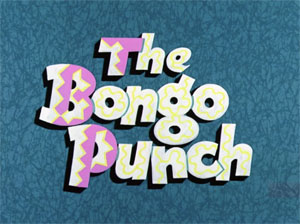 The Bongo Punch (Lantz/Universal, 12/28/57 – Alex Lovy, dir.) – Here;s one where the music takes center stage, spawning a specially-penned narrative song, “Pepito Chickeeto”, which carries us through the entire picture. Performance is credited to “Those Smiths” Trio, leaving one to speculate, since the only well-known Smith on the studio roster at the time was Paul J. Smith, if Paul and two of his relatives might have provided the vocal, perhaps having kicked the song around in a story session. One Irving Bibo is credited with the song’s music and lyrics.
The Bongo Punch (Lantz/Universal, 12/28/57 – Alex Lovy, dir.) – Here;s one where the music takes center stage, spawning a specially-penned narrative song, “Pepito Chickeeto”, which carries us through the entire picture. Performance is credited to “Those Smiths” Trio, leaving one to speculate, since the only well-known Smith on the studio roster at the time was Paul J. Smith, if Paul and two of his relatives might have provided the vocal, perhaps having kicked the song around in a story session. One Irving Bibo is credited with the song’s music and lyrics.
Plot is sort of a Trinidadian twist on that of the Harman-Ising Happy Harmony, “The Little Bantamweight”. A fighting rooster (Pepe) has just suffered resounding defeat in the fight arena, ending his professional career. He is carried home on a stretcher, and insists to his wife that he was robbed. But the little Missus has news to cheer the rooster up. An egg rests in a nest, and the hen announces they are in for a blessed event. Papa cheers that the hatchling-to-be will be the new champ. The big day arrives, as the chick’s feet emerge from the shell, stumbling about. “Look at that footwork”, marvels Papa. Young Pepito finally emerges into daylight, and Pop wants to waste no time in training, telling the kid to put up his dukes. Pepito gets the wrong first impression, and closes himself back up in the eggshell in fright.
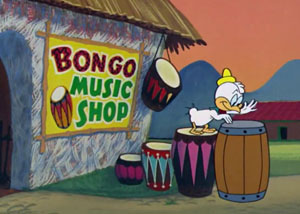 As Pepito grows to adolescence, Pop shows him the arena, where he claims someday Pepito will fight. But the prospect doesn’t hold Pepito’s interest. Instead, he finds himself fascinated by a local music store – and a set of bongo drums on display. Pepito takes right in to pounding away rhythmically upon such instruments. Papa doesn’t think things seem just right. At Pepito’s first birthday, the youth receives two gifts – boxing gloves from Dad, and bongo drums from Mom. Guess which Pepito adores, and which he ignores. Papa falls into a state of dejection – and the music is driving him crazy. Mama observes, and finally gives in to Dad, giving permission to teach Pepito to box fight. The drums are cast aside by Pop, and intensive training begins. Pop tells Pepito to adopt a fighting face for facing opponents in the ring, a mirror reflection of which frightens Pepito at the glance of himself. The only thing that keeps Pepito in training is the punching bag – a bead-filled maraca hanging upside-down from a hook. One bop – and Pepito hears his kind of rhythm. “Hey, Pop, this is the greatest”, remarks Pepito, earnestly punching away in tropical rhythm.
As Pepito grows to adolescence, Pop shows him the arena, where he claims someday Pepito will fight. But the prospect doesn’t hold Pepito’s interest. Instead, he finds himself fascinated by a local music store – and a set of bongo drums on display. Pepito takes right in to pounding away rhythmically upon such instruments. Papa doesn’t think things seem just right. At Pepito’s first birthday, the youth receives two gifts – boxing gloves from Dad, and bongo drums from Mom. Guess which Pepito adores, and which he ignores. Papa falls into a state of dejection – and the music is driving him crazy. Mama observes, and finally gives in to Dad, giving permission to teach Pepito to box fight. The drums are cast aside by Pop, and intensive training begins. Pop tells Pepito to adopt a fighting face for facing opponents in the ring, a mirror reflection of which frightens Pepito at the glance of himself. The only thing that keeps Pepito in training is the punching bag – a bead-filled maraca hanging upside-down from a hook. One bop – and Pepito hears his kind of rhythm. “Hey, Pop, this is the greatest”, remarks Pepito, earnestly punching away in tropical rhythm.
The night of the big fight arrives. It appears that the rooster who defeated Papa still holds the championship belt, so winning the fight becomes something personal. But Pepito is still like a fish out of water, unable to make an entrance from his unlit “dark corner” without getting socked back to where he started, and coming out again with a wooden water pail stuck upon his foot. He gives the pail a kick, landing it squarely over the champ’s head. “Hit him, Pepito”, shouts Papa. Pepito lands a begrudging tap upon the top of the pail – but hears a sound he likes best. “A drum!”, shouts Pepito. In no time, Pepito is bopping and pounding away on the pail, knocking the champ inside silly, and ends with a smashing bop to the pail where the champ’s chin would be, winning the fight and the crown. Pepito becomes an international celebrity with his “bongo punch”, gains fame and fortune, and most of all, a radio contract for musical performance. The cartoon ends there, though the Dell comics adaptation of the story, a faithful shot-for-shot retelling of the cartoon, includes a final panel where Papa, confused at how Pepito’s love of drums proved the deciding factor in his victory, now resigns himself to taking up beginner’s drumming music lessons, with an added lyric of song line, “And Papa goes boomp, one, two, three, four.”
The Pepito song received some atempt at exposure via recordings, with versions appearing on Decca (“The Woody Woodpecker Family Album”). Star-Bright, and Cricket records.
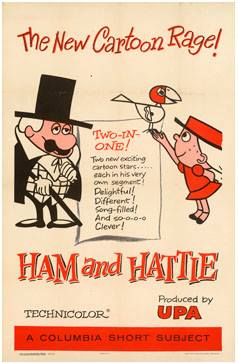 Trees and Jamaica Daddy (UPA/Columbia, Ham and Hattie, 12/29/57) was not exactly my cup of tea. It was the first of only four films produced in the experimental “Ham and Hattie” series – an excuse for a concept that was essentially a dress-rehearsal for the kind of miscellaneous short films which would populate The Boing Boing Show on CBS. Each film consisted of two short films crammed into the allotted six minutes, with entirely separate credits and directors. The Hattie elements were about a little girl and her ukelele-backed melodies, and might be said to bear a smattering of resemblance to the Turwiliger Twins shorts which appeared on the Boing Boing Show – only far less funny. The “Ham” portion of the series title allegedly referred to a moustached stage actor named Hamilton Ham. However, we never once in the four episodes produced see Ham perform as himself. Instead, he merely disappears into a wardrobe trunk, and emerges completely made-up as someone who looks entirely different – allowing the studio to virtually drop in any miscellaneous cartoon it wants to for the segment, allegedly with Hamilton starring as whoever the lead character happens to be in the film selected. What a cheat!
Trees and Jamaica Daddy (UPA/Columbia, Ham and Hattie, 12/29/57) was not exactly my cup of tea. It was the first of only four films produced in the experimental “Ham and Hattie” series – an excuse for a concept that was essentially a dress-rehearsal for the kind of miscellaneous short films which would populate The Boing Boing Show on CBS. Each film consisted of two short films crammed into the allotted six minutes, with entirely separate credits and directors. The Hattie elements were about a little girl and her ukelele-backed melodies, and might be said to bear a smattering of resemblance to the Turwiliger Twins shorts which appeared on the Boing Boing Show – only far less funny. The “Ham” portion of the series title allegedly referred to a moustached stage actor named Hamilton Ham. However, we never once in the four episodes produced see Ham perform as himself. Instead, he merely disappears into a wardrobe trunk, and emerges completely made-up as someone who looks entirely different – allowing the studio to virtually drop in any miscellaneous cartoon it wants to for the segment, allegedly with Hamilton starring as whoever the lead character happens to be in the film selected. What a cheat!
“Jamaica Daddy” was a Ham element, directed by Fred Crippen, with music composed and probably performed by songwriter Mel Leven (who composed many pieces for UPA, such as “Three-Horned Flink”, “Fight On For Old”, and “Winter Sports”, plus dabbled in work for Disney, including “Cruella De Vil”. “Kanine Krunchies Kommercial” and “The Litterbug”.). Here, he contributes a calypso number entitled “The Fam-lee Tree”, while Ham allegedly performs as an island native, backed by the singing and playing of two neighbors, singing of the days when his Dad told him to choose a bride and fulfill his responsibility by perpetuating the family tree. A wedding quickly occurs, a baby arrives in a year, and they like it so much, they have 24. Grandkids soon arrive, and Pop says Ham has done a good job. There’s not much else to say about the song or plot – after that, can there be much more to say?
The Motion Picture Academy, at the time enamored with anything UPA, actually issued a certificate of nomination to this film. Thankfully, it lost, in a vote that probably wasn’t even close, the award going to Tweety’s Birds Anonymous. Too bad we never see the final vote tallies for Oscar, as it would be nice to confirm the suspicion that this item scored dead last.
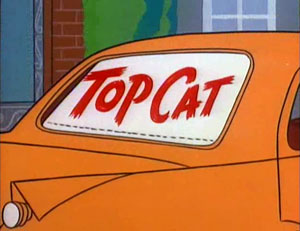 Choo Choo’s Romance (Hanna-Barbera, Top Cat, 12/6/61) – Top Cat is irked when his pal Choo Choo shows up late for TC’s class in “English” – as in fancy shots at the racked balls in the local pool hall. What could cause Chooch to commit such a breach of protocol? A French female cat who has moved in to an apartment nearby, named Goldie. Hearts are in Choo Choo’s eyes, and his cue ball can’t even hit anything but his own head when it’s time for his shor. TC sees only one solution. Familiarity breeds contempt – so the quicker he brings this pair of lovebirds together, the quicker he can break them apart again. Thus begins a series of misadventures where TC plays matchmaker, attempting to set Choo Choo up in situations that will catch the girl’s eye. Unfortunately, there are two primary obstacles. One, a French boyfriend, who already has his foot in the door. Two – and even worse – Choo Choo himself, who is incurably shy, and entirely awkward when it comes to expressing himself romantically.
Choo Choo’s Romance (Hanna-Barbera, Top Cat, 12/6/61) – Top Cat is irked when his pal Choo Choo shows up late for TC’s class in “English” – as in fancy shots at the racked balls in the local pool hall. What could cause Chooch to commit such a breach of protocol? A French female cat who has moved in to an apartment nearby, named Goldie. Hearts are in Choo Choo’s eyes, and his cue ball can’t even hit anything but his own head when it’s time for his shor. TC sees only one solution. Familiarity breeds contempt – so the quicker he brings this pair of lovebirds together, the quicker he can break them apart again. Thus begins a series of misadventures where TC plays matchmaker, attempting to set Choo Choo up in situations that will catch the girl’s eye. Unfortunately, there are two primary obstacles. One, a French boyfriend, who already has his foot in the door. Two – and even worse – Choo Choo himself, who is incurably shy, and entirely awkward when it comes to expressing himself romantically.
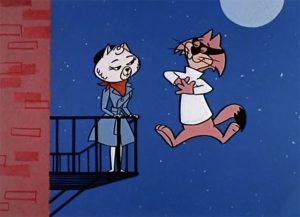 Midway through the story, at approximately 15:25, TC sets up a Romeo and Juliet-style balcony scene, complete with musical serenade. TC conducts the gang in song from behind a fence, while Choo Choo makes aerial visits to Goldie’s fire escape via trampoline jumps. Though the target girl is French, TC oddly chooses to compose a calypso for the musical interlude (one of the only original musical compositions to be featured in the series). Though the feline crooning of the gang is dubbed in by some professional singers who know what they’re doing (no sign of Maurice Gosfield’s off-key wailing as heard on “Sgt. Bilko”), it’s a pleasure that a couple of lines delivered by Choo Choo are actually performed by Marvin Kaplan in his signature Brooklynese character voice. Some sample lines from the piece, presumably composed by Hoyt Curtin and possibly Hanna and Barbera, include:
Midway through the story, at approximately 15:25, TC sets up a Romeo and Juliet-style balcony scene, complete with musical serenade. TC conducts the gang in song from behind a fence, while Choo Choo makes aerial visits to Goldie’s fire escape via trampoline jumps. Though the target girl is French, TC oddly chooses to compose a calypso for the musical interlude (one of the only original musical compositions to be featured in the series). Though the feline crooning of the gang is dubbed in by some professional singers who know what they’re doing (no sign of Maurice Gosfield’s off-key wailing as heard on “Sgt. Bilko”), it’s a pleasure that a couple of lines delivered by Choo Choo are actually performed by Marvin Kaplan in his signature Brooklynese character voice. Some sample lines from the piece, presumably composed by Hoyt Curtin and possibly Hanna and Barbera, include:
Choo Choo come to call on girl
She surely set his heart a-whirl
If Goldie wants her boy to see
She must come out on balcony
Moon in sky like pizza pie
Boy don’t meet girl, he surely die
So come on out and greet your (unclear)
You’re a pretty chick, but don’t be chicken!
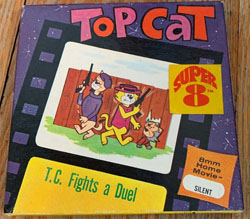 Choo Choo appears with a mask on during the balcony leaps, and TC plays Cyrano with poetic verse, wearing matching mask, to get Goldie in the mood when she comes down. But there is no time to make the switch to the inept Chooch’s fumbling self, as a pistol is thrust into TC’s mouth by the French boyfriend. Satisfaction is demanded, and a duel is scheduled. TC goes through with it – with the ace in the hole of sending Benny to fetch blank cartridges for the pistols. On cue, TC falls, and makes a last request that Goldie take Choo Choo in his place. But Choo Choo has had a change of heart, realizing he can’t talk the way Goldie likes, and that he misses the gang in the pool hall. Goldie, finding herself without a suitor, chases after her victorious French boyfriend, leaving the scene. TC revives, revealing his trick to Choo Choo, and Officer Dibble investigating the fired shot. But (in an out-of-character act of stupidity, which would more appropriately have suited Brain), Benny holds out the blanks, not in the guns, but still in his hands. TC finds a bullet hole in his hat, and realizes the duel was for real. He faints on the spot, and is carried away unconscious by Dibble and the gang for the fade out.
Choo Choo appears with a mask on during the balcony leaps, and TC plays Cyrano with poetic verse, wearing matching mask, to get Goldie in the mood when she comes down. But there is no time to make the switch to the inept Chooch’s fumbling self, as a pistol is thrust into TC’s mouth by the French boyfriend. Satisfaction is demanded, and a duel is scheduled. TC goes through with it – with the ace in the hole of sending Benny to fetch blank cartridges for the pistols. On cue, TC falls, and makes a last request that Goldie take Choo Choo in his place. But Choo Choo has had a change of heart, realizing he can’t talk the way Goldie likes, and that he misses the gang in the pool hall. Goldie, finding herself without a suitor, chases after her victorious French boyfriend, leaving the scene. TC revives, revealing his trick to Choo Choo, and Officer Dibble investigating the fired shot. But (in an out-of-character act of stupidity, which would more appropriately have suited Brain), Benny holds out the blanks, not in the guns, but still in his hands. TC finds a bullet hole in his hat, and realizes the duel was for real. He faints on the spot, and is carried away unconscious by Dibble and the gang for the fade out.
The show made the rounds of home movies, as one of only two early releases from the program available at 200 feet and in color, under the new title, “Top Cat Fights a Duel.” If you take the time to customize a soundtrack to run with the reel, it was a nice touch that a considerable amount of the calypso footage was included.
• The complete, in color and sound, “Choo Choo’s Romance” is on ok.ru.
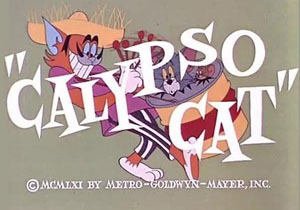 Calypso Cat (Rembrandt Films/MGM, Tom and Jerry, 6/22/62, Gene Deitch, dir.), features no calypso lyrics – after all, Tom and Jerry was largely a pantomime series. However, it includes appropriate instrumental music, via a steel band musical track. Most of the cartoon isn’t really on the subject, instead tracking the progress of T&J in an extended chase along a cruise ship’s dock (Tom trying to clobber Jerry with a large piece of hawser rope, its strands extending like flowing curls from Jerry’s head), which is broken up by the appearance of Deitch’s design for Toodles, boarding the ship at the gangplank. Tom is smitten as usual, and Jerry can’t get his attention, either by giving hum a hotfoot, or inserting Tom’s whole foot in an entire box of lit matches. Tom gains passage by leaping in a porthole, then steals a tray from a ship’s waiter to play steward to Toodles in her deck chair. Jerry tries to break up the romance, jiggling loose the rear support bar of the deck chair, so that Toodles’ meal winds up all over her face, then setting up a truck bouquet of flowers, set in a vase which is really the nozzle end of a high-pressure fire hose. When the ship docks in the Caribbean, Tom is beside himself with remorse for the voyage’s events, and begs on his knees for forgiveness from Toodles. To Jerry’s frustration, Toodles relents, and the two walk off arm in arm to take in the sights of the island.
Calypso Cat (Rembrandt Films/MGM, Tom and Jerry, 6/22/62, Gene Deitch, dir.), features no calypso lyrics – after all, Tom and Jerry was largely a pantomime series. However, it includes appropriate instrumental music, via a steel band musical track. Most of the cartoon isn’t really on the subject, instead tracking the progress of T&J in an extended chase along a cruise ship’s dock (Tom trying to clobber Jerry with a large piece of hawser rope, its strands extending like flowing curls from Jerry’s head), which is broken up by the appearance of Deitch’s design for Toodles, boarding the ship at the gangplank. Tom is smitten as usual, and Jerry can’t get his attention, either by giving hum a hotfoot, or inserting Tom’s whole foot in an entire box of lit matches. Tom gains passage by leaping in a porthole, then steals a tray from a ship’s waiter to play steward to Toodles in her deck chair. Jerry tries to break up the romance, jiggling loose the rear support bar of the deck chair, so that Toodles’ meal winds up all over her face, then setting up a truck bouquet of flowers, set in a vase which is really the nozzle end of a high-pressure fire hose. When the ship docks in the Caribbean, Tom is beside himself with remorse for the voyage’s events, and begs on his knees for forgiveness from Toodles. To Jerry’s frustration, Toodles relents, and the two walk off arm in arm to take in the sights of the island.
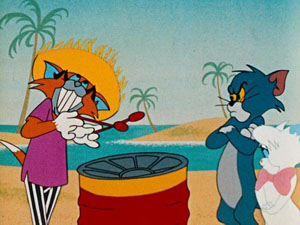 Now comes the calypso part. A handsome orange island cat is encountered, playing steel drum for the tourists. Tom wants to pass him by, but Toodles holds him back, taken by the music. The island cat’s solo continues, while Jerry, unseen behind the drum, ponders what can be done next. A large stone in the sand provides the answer. The islander’s tune is abruptly interrupted by a “CLANK:, as Jerry smacks the stone on the bottom of the drum. The orange cat glares at Tom, suspecting him as the meddling culprit, but Tom plays it innocent. The music continues, and again another “CLUNK”. Now, the orange tabby lifts his drumsticks high, and starts beating out a rhythm on Tom’s head. Tom retaliates, grabbing the sticks to play a tune on the tabby’s dome. The orange cat grabs Tom’s head, and starts whacking it into the top of his drum, producing more tone variations, and adding to them by banging on Tom’s head again with the drumsticks while he is down. Then, for a finale note, the tabby grabs up the drum, inverts it, lifts it high, and brings it down with a crash onto Tom’s back. Tom emerges from underneath with his back indented from the squares pressed into the drum surface, looking like he has acquired a new turtle shell. The tabby resumes his normal playing, and dances away, accompanied by Toodles, leaving Tom flipped over on his back, as helpless as the species which his back now resembles. Jerry doubles up with laughter, and as Tom finally begins to regain his original shape, and realizes his dream of love has danced away, Jerry once again applies the old hotfoot. The chase is on again, as the two race back aboard ship, the ship returns to home port, and T&J disembark, Tom again trying to whack Jerry with the hawser rope, leaving us for the fade out exactly where we came in.
Now comes the calypso part. A handsome orange island cat is encountered, playing steel drum for the tourists. Tom wants to pass him by, but Toodles holds him back, taken by the music. The island cat’s solo continues, while Jerry, unseen behind the drum, ponders what can be done next. A large stone in the sand provides the answer. The islander’s tune is abruptly interrupted by a “CLANK:, as Jerry smacks the stone on the bottom of the drum. The orange cat glares at Tom, suspecting him as the meddling culprit, but Tom plays it innocent. The music continues, and again another “CLUNK”. Now, the orange tabby lifts his drumsticks high, and starts beating out a rhythm on Tom’s head. Tom retaliates, grabbing the sticks to play a tune on the tabby’s dome. The orange cat grabs Tom’s head, and starts whacking it into the top of his drum, producing more tone variations, and adding to them by banging on Tom’s head again with the drumsticks while he is down. Then, for a finale note, the tabby grabs up the drum, inverts it, lifts it high, and brings it down with a crash onto Tom’s back. Tom emerges from underneath with his back indented from the squares pressed into the drum surface, looking like he has acquired a new turtle shell. The tabby resumes his normal playing, and dances away, accompanied by Toodles, leaving Tom flipped over on his back, as helpless as the species which his back now resembles. Jerry doubles up with laughter, and as Tom finally begins to regain his original shape, and realizes his dream of love has danced away, Jerry once again applies the old hotfoot. The chase is on again, as the two race back aboard ship, the ship returns to home port, and T&J disembark, Tom again trying to whack Jerry with the hawser rope, leaving us for the fade out exactly where we came in.
• “Calypso Cat” can be seen on Dailymotion
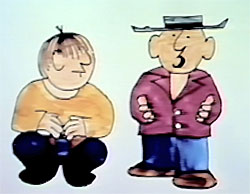 The Calypso Singer (Paul Glickman, 1965) is a wonderful piece of recording history, married to what Thunderbean would refer to as a mid-century modern visual, effectively providing visuals for Stan Freberg’s classic comedy record satire upon Harry Belafonte’s hit, “The Banana Boat Song”, straight from Freberg’s Capitol recording. It tells the hilarious doings of the recording session in which the song was made (though with a white cast), with the lead singer entering into a mild war of words and wit with the bongo drummer, who finds his singing and calypso shouts “too piercing”, and doesn’t dig songs about spiders. The only compromise which can be reached is to take the singing outside the studio on every shout – an arrangement that works even better for the drummer when the singer locks himself out. Fun stuff, especially if you’re a first-timer in exposure to the Freberg record. Even if not, the adaptation is such a nice fit, and received Freberg’s full approval.
The Calypso Singer (Paul Glickman, 1965) is a wonderful piece of recording history, married to what Thunderbean would refer to as a mid-century modern visual, effectively providing visuals for Stan Freberg’s classic comedy record satire upon Harry Belafonte’s hit, “The Banana Boat Song”, straight from Freberg’s Capitol recording. It tells the hilarious doings of the recording session in which the song was made (though with a white cast), with the lead singer entering into a mild war of words and wit with the bongo drummer, who finds his singing and calypso shouts “too piercing”, and doesn’t dig songs about spiders. The only compromise which can be reached is to take the singing outside the studio on every shout – an arrangement that works even better for the drummer when the singer locks himself out. Fun stuff, especially if you’re a first-timer in exposure to the Freberg record. Even if not, the adaptation is such a nice fit, and received Freberg’s full approval.
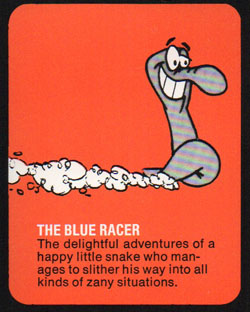 The Boa Friend (DePatie-Freleng, The Blue Racer, 2/11/73 – Gerry Chiniquy, dir.) – With about half of the films of this one-season theatrical series already in the can, and nearly all of them featuring a Japanese Beetle which would get the series into stereotype trouble, removing any thought of broad television resyndication, the writers finally decided for this episode to pull a switch, coming up with a new insect to interact with the super-speedy snake who fills the starring role of the series. A bee from Trinidad, whose entire speech is delivered in Calypso melody and verse, intercedes as a sort of Dan Cupid and source of advice to the lovelorn, trying to assist the Racer in his hapless efforts to impress a young she-snake, Honey Fang. However, Honey has broken off her engagement to the Racer, preferring the muscular-type – a boa constrictor, who in brotherly manner gives “the old grip” to the Racer – leaving the latter all “broken up” at the loss of his girl. The bee gives out with his first piece of advice – say it with flowers. The racer presents Honey with a bouquet, but not before the boa sprinkles pepper on it from a tree above. Honey’s sneezes lead to her tossing stones at the Racer with her tail. The Racer complains that “She’s rocking her dreamboat.”
The Boa Friend (DePatie-Freleng, The Blue Racer, 2/11/73 – Gerry Chiniquy, dir.) – With about half of the films of this one-season theatrical series already in the can, and nearly all of them featuring a Japanese Beetle which would get the series into stereotype trouble, removing any thought of broad television resyndication, the writers finally decided for this episode to pull a switch, coming up with a new insect to interact with the super-speedy snake who fills the starring role of the series. A bee from Trinidad, whose entire speech is delivered in Calypso melody and verse, intercedes as a sort of Dan Cupid and source of advice to the lovelorn, trying to assist the Racer in his hapless efforts to impress a young she-snake, Honey Fang. However, Honey has broken off her engagement to the Racer, preferring the muscular-type – a boa constrictor, who in brotherly manner gives “the old grip” to the Racer – leaving the latter all “broken up” at the loss of his girl. The bee gives out with his first piece of advice – say it with flowers. The racer presents Honey with a bouquet, but not before the boa sprinkles pepper on it from a tree above. Honey’s sneezes lead to her tossing stones at the Racer with her tail. The Racer complains that “She’s rocking her dreamboat.”
The bee suggests a serenade, but the Racer’s voice is one for the books as to being off-key. So, the bee makes a record in a recording booth, and instructs the Racer to pantomime to it. The expected problem with a skip in the record on playback reveals the charade, and crack goes the record over the Racer’s head. Finally, the bee suggests a voodoo brew, to grow a head of hair on the girl’s head. The potion works when splashed on her noggin, but the hair she sees as lovely sticks straight out from her skull in all directions. She attempts to show off to the boa, but receives the unexpected reaction of his breaking out in laughter. Shut up, Homer”, she repeats twice, the last more irritated than the first – then clubs Homer over the head, knocking him cold, as she yells, “COOL IT”. It seems the romance with the constructor is over, and she turns back to the attentions of the Racer. But the Racer’s eyes have been turned – by a passing friendly little female garter snake. Honey Fang finds herself dumped and jilted. The bee appears, now with helpful hints to win back her fiancé. Honey quickly dispatches of the bee with a fly-swatter blow, stating she’s had enough of him, too. The battered bee limps along in flight through the air, heading for the horizon, weakly singing. “I used to be happy, but now I’m sad. I think I go back to Trinidad.”
I hope this little musical interlude provided some laughs and good rhythm. We’ll move on to another new subject next week.
• Thanks to James Parten for an assist on some of the discographical research.